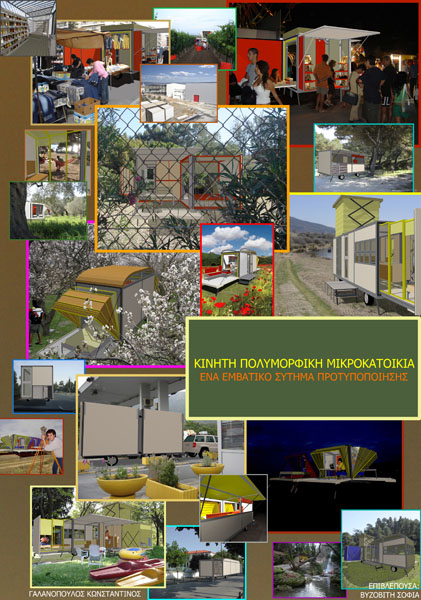



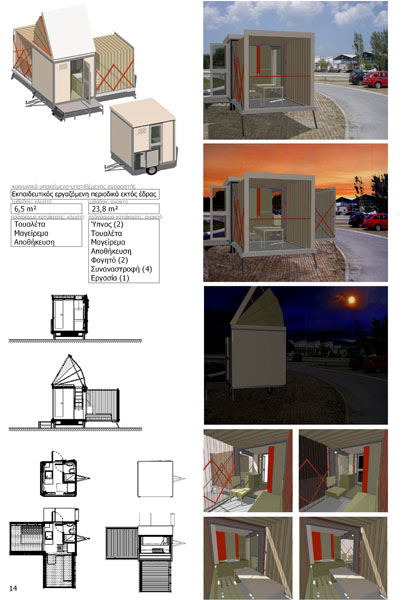



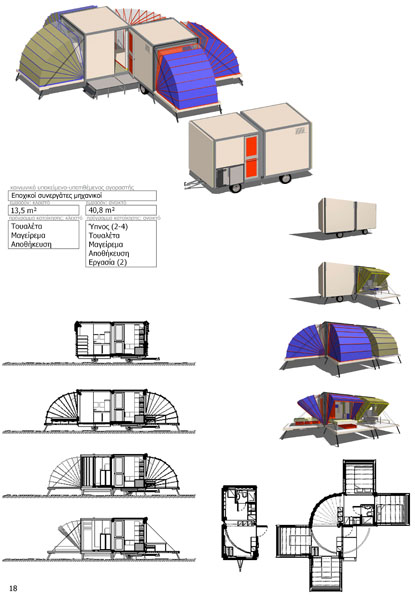



The proposal aims to redefine the trailers and provide them with a degree of flexibility that ensures their ability to adapt the individual needs of each customer. It explores the opportunities of prefabrication along with the restrictions of the rules of transportation, aiming to the creation of stimulating living environments which support a mobile way of living. It is a typology of embaticaly designed structural skeletons, on to which a series of transformations that increase the living area, surfaces which transform, or are divided by lines or columns of windows, can be adjusted according to the buyers wish. The maximization of the dwelling program within the flexible envelope is achieved with the use of multi-functioning furniture and optimum storage spaces, which are all designed as subdivisions of the embat, thus combined together in multiple ways.
Supervisor: Vyzoviti Sophia
Reference Number: 87
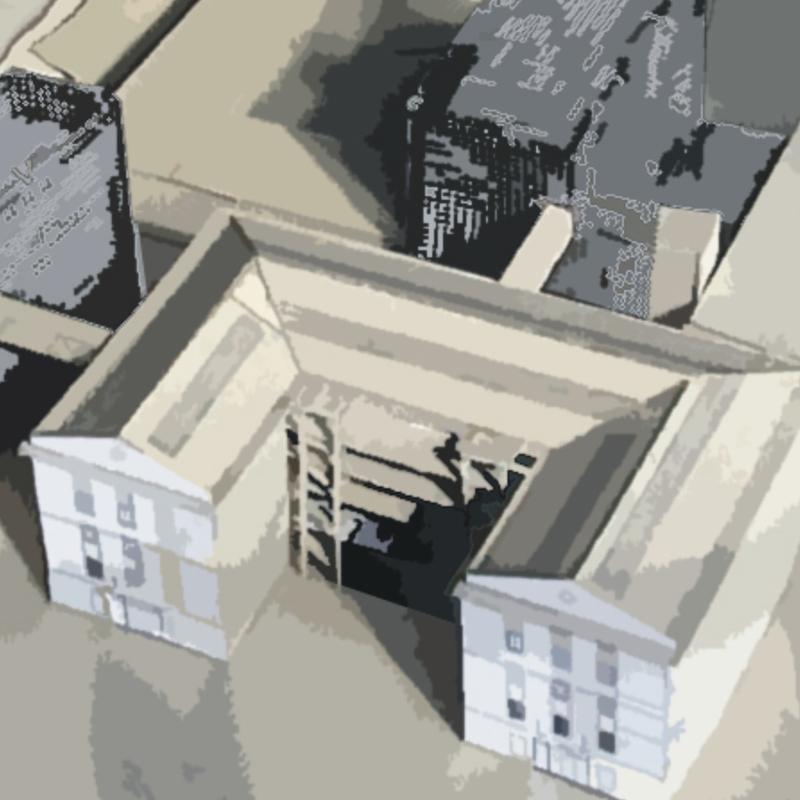









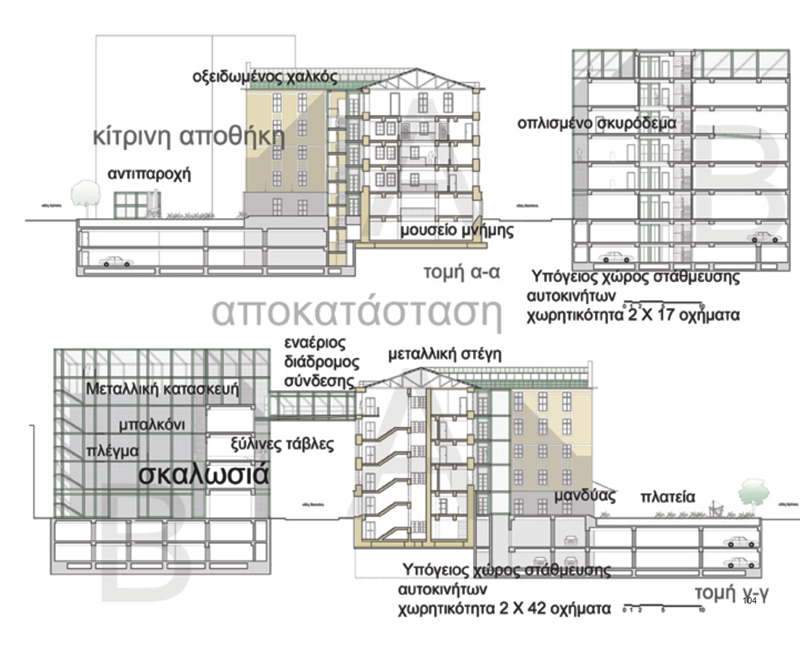

The main subject of the project was «Kitrini arothiki» (the yellow warehouse), a historic building for the city of Volos. This building is laying in the center of the city, at the crossing of Vassani str. and Gazi str. It is consisted of the basement, the ground floor and four more floors above that. Its total area is 6.250 m2.
The project concerns about the restoration and re-use of the building and the setting of the adjacent privately owned lots placed on Gazi, Krittski, Konstanta and Vassani str. . The intention of the creation of the yellow warehouse’s square has as a result the demolition of the one floor buildings of these lots . This attempt will contribute to the creation of an open public space in the area and to the designation of the existing building and the new installations that are suggested to be built, will rise this areas significance .
The suggested use of these buildings is perfectly compatible with the style and architecture of an industrial building and are conformable with aspects of the city authorities. The suggested use is the same with the suggested ones for the municipal historical center. The study of the municipal historical center has already been approved and it is about to be implemented.
During the process of this study there has been an comprehensive historical documentation and detection of the faces of the building process, detection of the pathology of the building and an analytic planning of present state.
The proposal of the restoration and re- use of the building is based on the conclusions of this research and respects the main characteristics of the existing building. The new constructions are unobtrusive as it concerns their style, architecture and color so as to declare the historical meaning of the existing building as a monument. One of the main aspects is that this project is based on reality and is accomplishable.
Supervisor: Adamakis Kostas
Reference Number: 110


The exploration of the possibility to design a student dormitories building, which one, through its architectural solution, it will contribute to the every day interaction of its inhabitants, while at the same time it will participate in a continuous dialogue with the city, it constituted the main questioning, which played a protagonist role to the project’s evolution. The student dormitories building it owes and has to represent an idealistic community’s micrography, in which will be achieved free and unconstrained trading of thoughts and ideas, collective and social conscience.
In which degree the architecture of a student dormitories building can contribute to a social activation?
The aim is that the building will function as a vital element of the university’s space, as well as an important core of the social community, in which the inhabitants will not find just a space to sleep and the citizens will not face it as a multi-dwelling but as a “citydwelling”. Terms as interaction, reconciliation, perforation, gathering, cutting, private, public, porous, transparent, hive, constituted key words during the whole procedure of the project.
Supervisor: Trova Vasso
Reference Number: 91






After a continuant and interminable research on the sound existence into the city view and likewise on the musicality in architecture, we came up against a question. How can a city create a sound phrase? A city, which is an experience of architecture, how can that be understood as a sound experience?
In our effort to give certain answers, in such a multidimensional theme such as this, we organized a project in order to find the sound transitions into the city view. Coming to a satisfactory point of this theme’s analysis, presently we turn over the terms and we are searching the opposite. How can a sound phrase build a city? How can a sound essence become the motivation in a form structure? Can this transition be attainable?
Transitions of experimentations come to a synthesis, a graphic design come to a structure, a path come to a usage and finally, a trip come to hospitality. A transport station.
Historically, Volos had the most important port after Peireus and Thessaloniki. Today that importance has been lost. Our intention is to convert that port into meeting point of complex transports again, and promote the substance of converse between habitants and visitors.
Supervisor: Kotionis Zissis
Reference Number: 74


The subject of this diploma thesis is the sanitation of an abandoned industrial building at the Ietionia Coast, on a symbolically tense spot in the harbour of Piraeus and its reuse as a Museum of the Emigrant Hellenism, with the utter ambition to constitute a cultural centre, a vivid and active communication channel between the Greeks here and those that have been disseminated.
The Museum will be focusing on the social phenomenon of immigration in an anthropological manner, inviting the visitor on a journey through the eyes of the Greek Immigrant. This journey will be starting on the harbour of Piraeus, point of separation and departure for numerous harbours of the world and will have as destination the constantly changing present. The spectrum of the thematology will be covering the conjuring up of the harbour of Piraeus at the times of the massive migration waves, the first discomforts and torments of the journey and the arrival, the first shy steps and the gradual integration of the immigrant Greeks in the society, their lives and their activity up to today, always in reference to the person and the feelings. In addition to the museum, other adjacent uses, such as lectures, temporary expositions, projections, a library with studying space, administrative offices and a restaurant will be completing the spectrum of uses.
The study includes the proposal for the transformation of the warehouse and the designing of a new building, were all adjacent uses will be accommodated. For the designing of the new building certain general principles are being followed, as to the geometry and the characteristics of the existing building, which are being translated into a contemporary architectural language.
The connection and the aesthetical unification of the two buildings is materialized through a central vertical node of auxiliary operations and exterior staircases, which are being connected via oblong aisles running along both buildings. These aisles a triple importance, as they provide horizontal communication, shade to the immediate lower glass surface, while intensifying certain poetic characteristics of the existing building.
The museum will be connected to the city of Piraeus through the road arteries of the city and the proposed reuse of an old small train, which will be reaching the Electric Railway terminal. As far as the surrounding space is concerned, parking spaces will be designed and the sum of the jetty will be subjected to landscape designing, in order to be attributed to the public.
Throughout the researching, the studying and the designing, the primary concern and a fundamental value which formed a sort of axis were the elevation and the establishment of the identity, certain characteristics and qualities of the building, as well as the surrounding space. Yet, the motivating thought and the utter goal of this degree thesis is the exploitation of existing while abandoned building reserve in vital spaces, in even seemingly caressed places, for the accommodation of demanding, as far as space is concerned, in a way that will not worsen the already stifling nature which conditions the average big Greek city.
Supervisor: Theologidou Cleopatra
Reference Number: 96




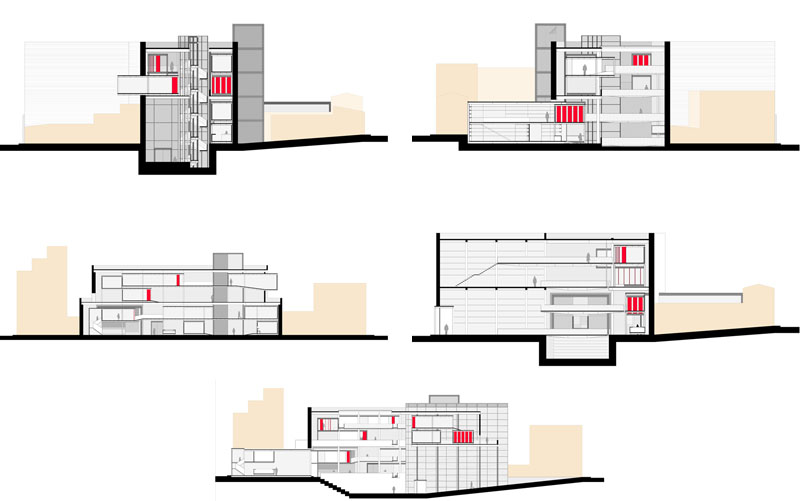



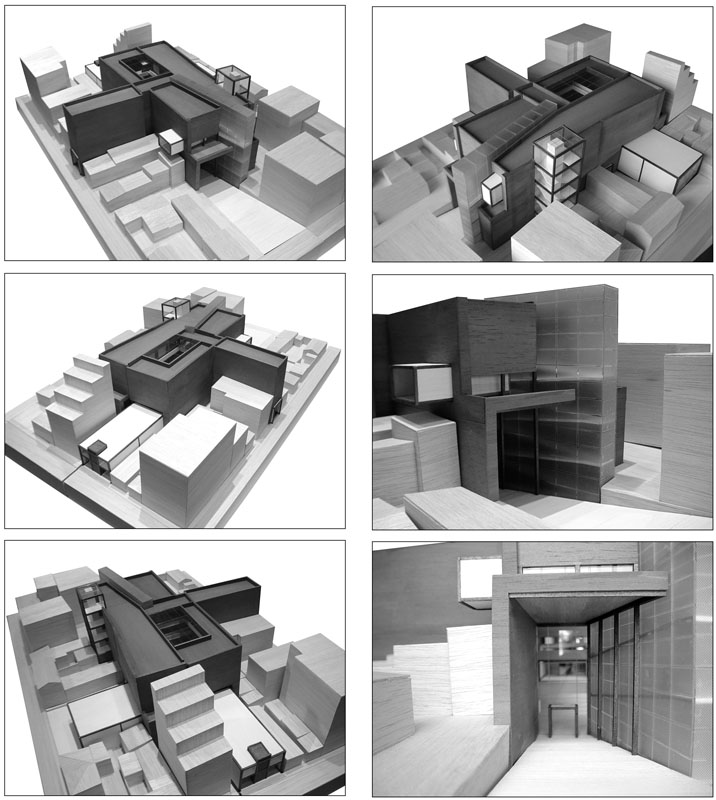



Athens, Gazi, Vasiliou the Great street, Dyaleon street, Gefireiou street, Achniadon street.
Achniadon 24, there is situated the building that houses from 1932 the settings workshop of the former Royal and present National Theatre. Our proposal concerns the transformation of the building into a scenography school with spaces open to public, as exhibition spaces, library, cafe, theatre.
The workshop was initially an orthogonal one-storied stone building and later a two-storied T shaped building that was always situated in the centre of the block, where in one typical block we find the open space of the blocks of flats.
The surrounding low houses of the block and the empty sites give their place in blocks of flats. The building progressively loses optical contact with the street.
Our proposal gives to the block the communal space that is needed, without removing a building which place and use can become a important pole of attraction for a developing region.
The idea of architectural composition follows the logic with which the building was extended up to now. It is based on the preservation of the skin of the existing building and on its extension with oblong volumes that penetrate the skin of the building with a purpose to reach the street. Our proposal tries to anticipate the further hemming of the building from blocks of flats, extending in neighbouring empty sites or sites with abandoned houses.
The site had already facets in the two longer sides of the block, defining an axis perpendicular to the basic volume of the building. In our proposal we draw another axis from side to side at the other dimension, creating entries at the four sides of the block. The axis begins from a wide ramp that leads in the building, to a 20 metre high free space, roofed with a glass ceiling, that constitutes also the core of the building. In this space there is a small theatre with bleachers that scale to the cafe. All these spaces, along with exhibition spaces and a library are open to the public also. Parallel to the axis, a glass oblong volume with ramps, that "rip" the big compact volume, is positioned.
Regarding the interior of the building, closed individual spaces were needed, thus exploiting the height of 8 metres of two floors of the building, we create metal "boxes" close to the human scale in order to ensure auxiliary spaces, exhibition spaces, offices of professors but mainly spaces for teaching.
Supervisors: Vrontissi Maria, Papadopoulos Spiros
Reference Number: 76


Starting from the Ancient Times until Byzantine Hemettu’s History has been combined with the religious worship. Nowadays, a great number of monasteries supports this relationship between Hemettu and the sacred.
After creating a monastic structure having been chosen as the main theme of this Academic Thesis, Hemettu was chosen as the broader spatial frame for the monastery. Through marches and parallel recordings of “spatial findings” the certain location of the monastery was confined. The area near the Ancient Quarries of “Karas”, a place at the West side of Hemettu, is being proposed as the site of a Men’s Monastery on the honor of Saint Gregorios Palamas.
Two plateau exist on the intensive bas-relief of this area. Monastery is going to be situated on the one of them. A stone’s elaboration laboratory is going to be situated on the other one, which was the corn of the ancient quarry.
The combination of these two main spatial poles is fulfilled through a route which was designed according to the gradual movement from the “place of prayer” to the “place of work”.
Supervisor: Manolidis Kostas
Reference Number: 90
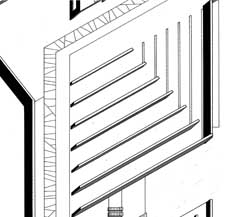

The project is a work on the creation of a burial site for the Jewish community of Athens, for at least 70 years of use for burials. This work is an attempt to solve existent problems of the community. The lack of a site far away from settlements, the vitiation of tomb forms because of the proximity of Jewish and Christian cemeteries, the excessive and weighty tombs, the insufficient, in general, planning of existent cemeteries have created the need to revise our views on Jewish cemeteries.
The site which was chosen for the implementation of the project is located near the new bridge of Chalkida and combines all of the elements that were considered prerequisites from the beginning of the project. These elements are the existence of water (sea or lake) at the eastern side of the site, the distance from any settlements or towns, the easy access, and the location opposite of the city of Chalkida (due to the emphasis given to the local burial site).
The project includes four buildings: the Bet-a-Taara, for the washing of the dead body, the building for funerary ceremony- Levaya, another for the first lunch of the family after the funeral and one for restrooms and offices. All of the elements have been designed on two axes: towards the East (East-west, North- South) and towards the cemetery of Chalkida. There have been designed 2.408 tombs on the site, for the members of the community, and five emplacements for rabies’ tombs.
The connecting paths and transitional spaces are very important in the project because of their symbolism. The visitors walk close to 7 parallel walls before they can see the
Necropolis, just like the 7 circles around Jericho before the walls collapsed and a view of the city was possible. There are also set 12 lower walls and 12 small, floating platforms, as symbols of the 12 clans of Israel and reminders of the passing of the people through river Jordan (Jesus of Navi, 3:14).
In addition, the element of water is being emphasized because of its association with the story of Moses and the passing of the Red sea. Therefore, many water channels have been set on the site for symbolic reasons.
Last, in order for the project to be considered complete there have been designed tree types of tombs and a suggestion for the gravestones.
Supervisor: Kanarelis Theoklis
Reference Number: 78

